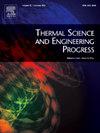Performance optimization of solar air heater with novel combination of sinusoidal absorber and angled baffles: A CFD and Taguchi approach
IF 5.1
3区 工程技术
Q2 ENERGY & FUELS
引用次数: 0
Abstract
This study provides a detailed analysis of an innovative solar air heater design, combining a sinusoidal absorber geometry with strategically placed angled baffles. The primary goal is to enhance the thermal performance of the device while reducing adverse pressure gradients. The investigation employed the Taguchi optimization methodology to systematically evaluate the influence of critical parameters, including Reynolds number (), pitch (), wave period (, and wave depth (, on thermohydraulic characteristics. A bidimensional numerical simulations were conducted by using ANSYS Fluent and based on the Renormalization Group (RNG) k-ε turbulence model. The optimal configuration, found at , , , and 8000, showed a thermal enhancement factor of 0.986. This result represents a significant improvement in thermohydraulic performance of about 15.05 % compared to conventional baffle-only system. An economic analysis of the optimized configuration was conducted, revealing substantial practical advantages. The optimized system generated a net annual energy output of 1,721.49 kWh, exceeding the smooth SAH baseline by 1,700.23 kWh. This results in annual savings of 256.97 €/kWh, representing an approximate 30 % improvement over previous optimal baffle configurations. These findings highlight the significant potential of integrating geometric modifications to improve solar air heater efficiency, while showcasing strong economic viability for practical application.
求助全文
约1分钟内获得全文
求助全文
来源期刊

Thermal Science and Engineering Progress
Chemical Engineering-Fluid Flow and Transfer Processes
CiteScore
7.20
自引率
10.40%
发文量
327
审稿时长
41 days
期刊介绍:
Thermal Science and Engineering Progress (TSEP) publishes original, high-quality research articles that span activities ranging from fundamental scientific research and discussion of the more controversial thermodynamic theories, to developments in thermal engineering that are in many instances examples of the way scientists and engineers are addressing the challenges facing a growing population – smart cities and global warming – maximising thermodynamic efficiencies and minimising all heat losses. It is intended that these will be of current relevance and interest to industry, academia and other practitioners. It is evident that many specialised journals in thermal and, to some extent, in fluid disciplines tend to focus on topics that can be classified as fundamental in nature, or are ‘applied’ and near-market. Thermal Science and Engineering Progress will bridge the gap between these two areas, allowing authors to make an easy choice, should they or a journal editor feel that their papers are ‘out of scope’ when considering other journals. The range of topics covered by Thermal Science and Engineering Progress addresses the rapid rate of development being made in thermal transfer processes as they affect traditional fields, and important growth in the topical research areas of aerospace, thermal biological and medical systems, electronics and nano-technologies, renewable energy systems, food production (including agriculture), and the need to minimise man-made thermal impacts on climate change. Review articles on appropriate topics for TSEP are encouraged, although until TSEP is fully established, these will be limited in number. Before submitting such articles, please contact one of the Editors, or a member of the Editorial Advisory Board with an outline of your proposal and your expertise in the area of your review.
 求助内容:
求助内容: 应助结果提醒方式:
应助结果提醒方式:


